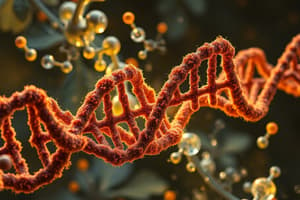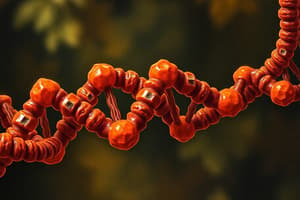Podcast
Questions and Answers
Which DNA polymerases are responsible for the replication of nuclear DNA in eukaryotes?
Which DNA polymerases are responsible for the replication of nuclear DNA in eukaryotes?
- DNA polymerases β, η, and ζ
- DNA polymerases α, β, and γ
- DNA polymerases α, δ, and ε (correct)
- DNA polymerases γ, δ, and ε
What fundamental direction do all DNA polymerases synthesize DNA?
What fundamental direction do all DNA polymerases synthesize DNA?
- 5' to 3' (correct)
- In both 5' to 3' and 3' to 5'
- In a circular direction
- 3' to 5'
What is the primary role of initiator proteins in the origin of replication?
What is the primary role of initiator proteins in the origin of replication?
- To separate the DNA strands completely
- To recognize specific nucleotide sequences (correct)
- To directly unwind the DNA helix
- To synthesize new DNA strands
How many origins of replication are typically found in mammalian genomes?
How many origins of replication are typically found in mammalian genomes?
What is the role of miRNAs in the cell?
What is the role of miRNAs in the cell?
What mechanism do helicase and single-stranded DNA-binding proteins use during replication?
What mechanism do helicase and single-stranded DNA-binding proteins use during replication?
Why is multiple origins of replication necessary in eukaryotes?
Why is multiple origins of replication necessary in eukaryotes?
What is a characteristic feature of long non-coding RNAs (lncRNAs)?
What is a characteristic feature of long non-coding RNAs (lncRNAs)?
What is the consequence of using a single origin of replication for the mammalian genome?
What is the consequence of using a single origin of replication for the mammalian genome?
Which of the following statements accurately describes the nuclear envelope?
Which of the following statements accurately describes the nuclear envelope?
What is a key distinction between the origin of replication in prokaryotes and eukaryotes?
What is a key distinction between the origin of replication in prokaryotes and eukaryotes?
What role does the nuclear pore complex play?
What role does the nuclear pore complex play?
What type of DNA sequence represents a significant portion of the human genome but does not encode functional genetic information?
What type of DNA sequence represents a significant portion of the human genome but does not encode functional genetic information?
What characteristic distinguishes the AT-rich and GC-rich sequences in the context of satellite DNA?
What characteristic distinguishes the AT-rich and GC-rich sequences in the context of satellite DNA?
How do long non-coding RNAs such as Xist RNA function in females?
How do long non-coding RNAs such as Xist RNA function in females?
Which structure underlies the inner nuclear membrane?
Which structure underlies the inner nuclear membrane?
What impact do deletions in residues 126 to 132 have on the T antigen?
What impact do deletions in residues 126 to 132 have on the T antigen?
Which sequence composition is typical for nuclear localization signals (NLS)?
Which sequence composition is typical for nuclear localization signals (NLS)?
What role do Importins play in the nuclear transport process?
What role do Importins play in the nuclear transport process?
What happens to the importin-cargo complex in the nucleus?
What happens to the importin-cargo complex in the nucleus?
What is the effect of high concentration of Ran/GTP in the nucleus?
What is the effect of high concentration of Ran/GTP in the nucleus?
What function do Ran proteins serve in nuclear transport?
What function do Ran proteins serve in nuclear transport?
What is a characteristic of proteins with bipartite nuclear localization signals, like nucleoplasmin?
What is a characteristic of proteins with bipartite nuclear localization signals, like nucleoplasmin?
Which process occurs after importin is released from the cargo protein?
Which process occurs after importin is released from the cargo protein?
What role do snoRNAs play in pre-rRNA processing?
What role do snoRNAs play in pre-rRNA processing?
How are ribosomal proteins incorporated into preribosomal particles?
How are ribosomal proteins incorporated into preribosomal particles?
What is the primary component of snoRNPs involved in rRNA processing?
What is the primary component of snoRNPs involved in rRNA processing?
Which type of RNA polymerase is responsible for transcribing the genes encoding ribosomal proteins?
Which type of RNA polymerase is responsible for transcribing the genes encoding ribosomal proteins?
What modification occurs to uridine during pre-rRNA processing?
What modification occurs to uridine during pre-rRNA processing?
What is the primary function of telomerase?
What is the primary function of telomerase?
Which of the following correctly defines extragenic DNA?
Which of the following correctly defines extragenic DNA?
What is the significance of alternative splicing in gene expression?
What is the significance of alternative splicing in gene expression?
How does the complexity of DNA relate to the number of genes and proteins?
How does the complexity of DNA relate to the number of genes and proteins?
Which type of RNA is known for playing fundamental roles in protein synthesis?
Which type of RNA is known for playing fundamental roles in protein synthesis?
Which type of sequences in human DNA are responsible for regulating gene expression?
Which type of sequences in human DNA are responsible for regulating gene expression?
What is the approximate number of different proteins that can be generated from 21,000 human protein-coding genes?
What is the approximate number of different proteins that can be generated from 21,000 human protein-coding genes?
Which of the following features is NOT part of a gene structure?
Which of the following features is NOT part of a gene structure?
What specific amino acid sequence is used to tag proteins for export from the nucleus?
What specific amino acid sequence is used to tag proteins for export from the nucleus?
What role does Ran-GEF play in the nucleus?
What role does Ran-GEF play in the nucleus?
Which exportin is specifically responsible for the transport of tRNA from the nucleus?
Which exportin is specifically responsible for the transport of tRNA from the nucleus?
How is NF-kB prevented from entering the nucleus in unstimulated cells?
How is NF-kB prevented from entering the nucleus in unstimulated cells?
What event allows the transport of Pho4 to the nucleus?
What event allows the transport of Pho4 to the nucleus?
What is the role of the hydrolysis of GTP in protein export from the nucleus?
What is the role of the hydrolysis of GTP in protein export from the nucleus?
What distinguishes mRNA export from tRNA and rRNA export?
What distinguishes mRNA export from tRNA and rRNA export?
Which of the following proteins directly binds to RNA for export?
Which of the following proteins directly binds to RNA for export?
Flashcards
Genome
Genome
The complete set of genetic material in an organism, including DNA.
Gene
Gene
A segment of DNA that codes for a specific product, like a protein or RNA.
Extragenic DNA
Extragenic DNA
DNA sequences that don't code for proteins. They may have other functions, like regulating gene expression.
Exon
Exon
Signup and view all the flashcards
Intron
Intron
Signup and view all the flashcards
Alternative splicing
Alternative splicing
Signup and view all the flashcards
MicroRNA (miRNA)
MicroRNA (miRNA)
Signup and view all the flashcards
Tandem repeats
Tandem repeats
Signup and view all the flashcards
miRNA
miRNA
Signup and view all the flashcards
RISC (RNA-induced silencing complex)
RISC (RNA-induced silencing complex)
Signup and view all the flashcards
lncRNA (long non-coding RNA)
lncRNA (long non-coding RNA)
Signup and view all the flashcards
Xist RNA
Xist RNA
Signup and view all the flashcards
Nuclear envelope
Nuclear envelope
Signup and view all the flashcards
Nuclear pore complex
Nuclear pore complex
Signup and view all the flashcards
Nuclear lamina
Nuclear lamina
Signup and view all the flashcards
Single sequence repeats
Single sequence repeats
Signup and view all the flashcards
Nuclear Localization Signal (NLS)
Nuclear Localization Signal (NLS)
Signup and view all the flashcards
Importin
Importin
Signup and view all the flashcards
Ran Protein
Ran Protein
Signup and view all the flashcards
Ran-GAP
Ran-GAP
Signup and view all the flashcards
Bipartite NLS
Bipartite NLS
Signup and view all the flashcards
Nuclear transport
Nuclear transport
Signup and view all the flashcards
Nuclear export
Nuclear export
Signup and view all the flashcards
Importin alpha
Importin alpha
Signup and view all the flashcards
DNA Polymerases in Eukaryotes
DNA Polymerases in Eukaryotes
Signup and view all the flashcards
Primer-Dependent Synthesis
Primer-Dependent Synthesis
Signup and view all the flashcards
Origin of Replication
Origin of Replication
Signup and view all the flashcards
Initiator Proteins
Initiator Proteins
Signup and view all the flashcards
Replication Forks
Replication Forks
Signup and view all the flashcards
Replication Complex (Replisome)
Replication Complex (Replisome)
Signup and view all the flashcards
Origin of Replication in Prokaryotes vs. Eukaryotes
Origin of Replication in Prokaryotes vs. Eukaryotes
Signup and view all the flashcards
Multiple Origins in Eukaryotes
Multiple Origins in Eukaryotes
Signup and view all the flashcards
Pre-rRNA processing
Pre-rRNA processing
Signup and view all the flashcards
Role of snoRNAs in pre-rRNA processing
Role of snoRNAs in pre-rRNA processing
Signup and view all the flashcards
Ribosome assembly process
Ribosome assembly process
Signup and view all the flashcards
Early association of ribosomal proteins
Early association of ribosomal proteins
Signup and view all the flashcards
5S rRNA in ribosome assembly
5S rRNA in ribosome assembly
Signup and view all the flashcards
Ran
Ran
Signup and view all the flashcards
Nuclear Export Signal (NES)
Nuclear Export Signal (NES)
Signup and view all the flashcards
Nuclear import regulation
Nuclear import regulation
Signup and view all the flashcards
mRNA export complex
mRNA export complex
Signup and view all the flashcards
Exportin-t and Exportin-5
Exportin-t and Exportin-5
Signup and view all the flashcards
Study Notes
Unit 3: The Nucleus
- The nucleus serves as a storehouse for genetic information
- DNA replication takes place at the genomic level
- RNA transcription and processing occur
- Gene expression is regulated by controlling the transport of transcription factors from the cytoplasm to the nucleus
Index
- 3.1: The cell nucleus and the DNA
- 3.2: Nuclear envelope
- 3.3: DNA replication
- 3.4: DNA transcription
- 3.5: Traffic between the nucleus and the cytoplasm
- 3.6: Nuclear bodies
3.1 The cell nucleus and the DNA
- Functions:
- Stores genetic information
- Site of DNA replication
- Site of RNA transcription and processing
- Regulates gene expression by controlling the transport of transcription factors
Chromosomes and chromatin
- Eukaryotic genomes are complex, organized on multiple linear chromosomes
- DNA is packaged with small proteins called histones
- The length of human DNA is 2 meters, but it must fit in a core of 5-10 micrometers within the nucleus
Chromosomes
- Tightly packaged DNA
- Found only during cell division
- DNA is not used for macromolecule synthesis
Chromatin
- Unwound DNA
- Found throughout interphase
- DNA is being used for macromolecule synthesis
Heterochromatin and euchromatin
- Heterochromatin: condensed chromatin, inactive for transcription
- Euchromatin: loose chromatin, active for transcription
Levels of DNA packaging
- Level 1: DNA double helix (2nm) coils around histone core to form nucleosome ("beads-on-a-string")
- Level 2: Nucleosomes coil to form 30nm chromatin fiber
- Level 3: 30nm fibers form loops attached to a protein scaffold, forming a 300nm fiber
- Level 4: 300nm fibers condense forming a 700nm fiber or chromatid which is further condensed
DNA polymerase
- Eukaryotes and prokaryotes contain DNA polymerases with different roles
- Bacterial DNA polymerase III is the main polymerase responsible for replication
- In eukaryotes, DNA polymerases α, δ and ε function in nuclear DNA replication, and DNA polymerase γ is for mitochondrial DNA replication
- DNA polymerases synthesize DNA 5' to 3'
Origin of Replication
- DNA molecule unwinds at specific points called origins of replication
- Initiator proteins recognize specific nucleotide sequences to facilitate the attachment of other proteins to form two replication forks
- A large replication complex (replisome) is assembled consisting of multiple enzymes and proteins
Origin of Replication in Prokaryotes
- Replication begins at one single origin
- Initiator protein unwinds the DNA, recruiting other replication enzymes
- Replication proceeds in both directions from the single origin
Origin of Replication in Eukaryotes
- Eukaryotes require multiple origins of replication to replicate long chromosomes in a reasonable time
- The rate of DNA replication is slower in eukaryotes than in bacteria due to DNA packaging in chromatin
Replication Fork
- The DNA molecule unwinds to separate parental strands forming two replication forks.
- One strand is synthesized continuously (leading strand) whereas the other in short fragments (lagging strand)
DNA Maintenance
- High accuracy in DNA replication is crucial for cell reproduction
- Error frequency is less than one incorrect base per 10,000 nucleotides
- Mechanisms for DNA polymerase fidelity include:
- Selecting correct bases
- Proofreading activity (3' to 5' exonuclease excises incorrect base)
Telomerase
- DNA polymerase involved in telomere formation
- Contains 159-nucleotide RNA oligonucleotide that acts as a template for telomere synthesis
- Replicates telomeric DNA
Genes and Genomes
- Genome: The complete set of genetic material in an organism
- Gene: A segment of DNA that codes for a specific gene product, either RNA or protein
- Extragenic DNA: DNA in a genome that does not contain protein-coding genes, but can have regulatory functions
DNA Quantity Paradox
- A larger genome does not necessarily correspond to a greater number of genes
- Complexity is a multi-faceted parameter and not only a matter of DNA quantity
Gene Structure: Introns and Exons
- Exons: Regions of mRNA that are expressed and form protein-coding sequences
- Introns: Non-coding regions of DNA that are removed during mRNA processing
Alternative Splicing
- Multiple mature mRNA transcripts can be generated from a single gene depending on which exons are included or excluded in the final mRNA
- Increases the diversity of proteins encoded by a single gene and plays a critical role in development and differentiation.
Complexity in Human DNA: Types of Sequences in our genome
- Regulatory DNA sequences include promoters, silencers, and enhancers
- Extragenic DNA includes repetitive sequences (tandem and sparse repeats), gene duplication, and pseudogenes
Noncoding RNA
- Diverse classes of noncoding RNAs play important regulatory roles in the cell (tRNAs, rRNAs, miRNAs, IncRNAs)
- miRNA: 20-30 nucleotides, control gene expression by inhibiting translation
- IncRNA: over 200 nucleotides, involved in regulating gene expression and chromatin structure
RNA Processing
- Bacterial mRNAs are used immediately for protein synthesis
- Many types of RNA (rRNA, tRNA, mRNA) in eukaryotes are processed extensively before being used to synthesize proteins.
Ribosomal RNAs
- rRNA molecules of both prokaryotes and eukaryotes are derived from a single long pre-rRNA molecule (cleaved into smaller mature rRNA)
- Each rRNA type (18S, 5.8S, 28S, 5S) is transcribed from a separate gene (except in the case of the 5.8S, 18S and 285 rRNAs, which are transcribed from a single long pre-rRNA molecule) in eukaryotes
tRNAs
- tRNA molecules are processed from longer precursors, requiring cleavage of both 5' and 3' ends
- Modification of specific bases in precursor tRNA (10%)
mRNA Processing (Eukaryotes)
- 5' cap
- 3' poly-A tail
- Splicing: removal of introns
Splicing
- Splicing proceeds in two steps:
- Cleavage and joining
- Excising intron loop
- Alternative splicing: multiple mature mRNAs from one gene
Nuclear Envelope and Pore Complex
- Double membrane structure surrounding the nucleus
- Nuclear pore complex is the pathway for selective transport between the nucleus and cytoplasm
- The nuclear lamina is a fibrous network that provides structural support to the nucleus
Selective Transport of Proteins
- Proteins required for nuclear functions are transported from the cytoplasm to the nucleus
- NLS (nuclear localization signals): specific amino acid sequences targeting particular proteins to the nucleus
- Importins: bind to NLSs, facilitating transport
- Ran proteins: regulate the directionality of transport
RNA Transport
- RNA molecules are transported through the nuclear pore complex, associated with proteins to form RNPs
- Different RNA types (tRNA, mRNA, rRNA, miRNA) use various mechanisms
Other Small Noncoding RNAs
- snRNAs (small nuclear RNAs): act in pre-mRNA splicing
- snoRNAs (small nucleolar RNAs): involved in rRNA processing
Nucleolos
- Large structure in the nucleus
- Site of ribosome biogenesis
Histone Modifications
- Acetylation: adding acetyl groups, relaxing chromatin, increasing transcriptional activity
- Methylation: adding methyl groups, affecting transcriptional activity
Chromatin Remodeling Factors
- Protein complexes that alter interactions between DNA and histones, impacting transcription
DNA Methylation
- Epigenetic mechanism for controlling transcription (often leads to repression)
- Methylation of cytosine bases preceding guanines (CpG dinucleotides)
Regulation of Transcription
- Mechanisms for regulating gene expression in eukaryotes by:
- Binding of regulatory proteins
- Chromatin structure modifications
- DNA methylation
- Noncoding RNA regulation
Nuclear Bodies
- Specific subnuclear structures that concentrate specific proteins and RNAs
- Include the nucleolus, cajal bodies, speckles, histone locus bodies, etc
Studying That Suits You
Use AI to generate personalized quizzes and flashcards to suit your learning preferences.
Related Documents
Description
Test your knowledge on the key processes in DNA replication, focusing on eukaryotic systems. Explore the roles of DNA polymerases, initiator proteins, and the significance of origins of replication. This quiz also delves into the functions of miRNAs and the structural characteristics of nuclear components.




